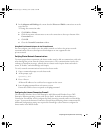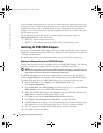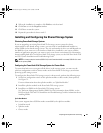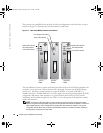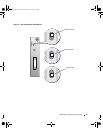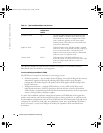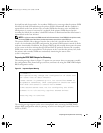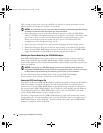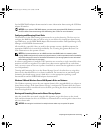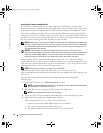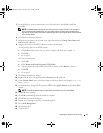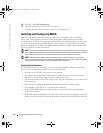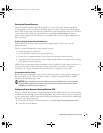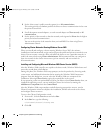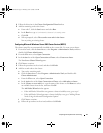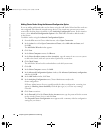
Preparing Your Systems for Clustering 45
See the PERC RAID adapter documentation for more information about setting the SCSI host
adapter ID number.
NOTICE: If you replace a PERC RAID adapter, you must set the appropriate SCSI ID before you connect
the SCSI cables to the shared storage. See "Maintaining Your Cluster" for more information.
Configuring and Managing Virtual Disks
The hard drives in the shared storage system must be set up for clustering. The first step is to
configure the RAID levels that you will be using in your cluster. For instructions about setting
up a RAID array, see the PERC RAID adapter documentation and the Dell OpenManage Array
Manager or Dell OMSM documentation.
All virtual disks, especially if they are used for the quorum resource, should incorporate the
appropriate RAID level to ensure high availability. See "Creating the Quorum Resource" for
more information on the quorum resource.
NOTE: Dell recommends that you use a RAID level other than RAID 0 (which is commonly called
striping). RAID 0 configurations provide very high performance, but do not provide the level of availability
required for the quorum resource. See the documentation for your storage system for more information
about setting up RAID levels for the system.
In a cluster configuration, if multiple NTFS partitions are created on a single virtual disk, these
partitions will fail over together. If you plan to run cluster-aware applications on each cluster
node, you must create at least two separate virtual disks to ensure that the applications can fail
over independently.
"Naming and Formatting Drives on the Shared Storage System" describes how to assign drive
letters to the shared hard drives in a cluster installation. For instructions on partitioning and
formatting the shared storage system’s hard drives, see the appropriate operating system
documentation and the PERC RAID adapter documentation.
Windows 2000 and Windows Server 2003 Dynamic Disks and Volumes
The Windows operating system does not support dynamic disks (upgraded disks) or volumes as
shared cluster storage. If the shared cluster storage is configured as a dynamic disk, the Cluster
Configuration wizard is not able to discover the disks, preventing the cluster and network clients
from accessing the disks.
Naming and Formatting Drives on the Shared Storage System
After the virtual disks are created, write the disk signature, assign drive letters to the virtual
disks, and then format the drives as NTFS drives. Format the drives and assign drive letters from
only one cluster node.
NOTICE: Accessing the hard drives from multiple cluster nodes may corrupt the file system.
se500wbk1.book Page 45 Thursday, June 16, 2005 4:19 PM



